Community Engagement Strategy for Ebola Virus Emergency Response Plan
VerifiedAdded on 2022/11/25
|7
|1466
|320
Report
AI Summary
This report provides a comprehensive emergency response plan for an Ebola virus outbreak, emphasizing community engagement and mobilization. It details a step-by-step approach, including engagement of stakeholders, consultation with health professionals and organizations, and the importance of community participation. The plan outlines the organization of response activities, capacity building through training programs, and decisive actions such as patient treatment and community education. The report also highlights the rationale for using a bottom-up approach, recognizing the critical role of local communities in rapidly responding to the threat of the disease. The report covers various stages of the process, including engagement, consultation, participation, organization, capacity building, and action. It also discusses the importance of community health workers and volunteers, and the need for law enforcement to ensure quarantine adherence. The report concludes by summarizing the key procedures and the rationale behind the bottom-up approach, which underscores the importance of local understanding and adherence to instructions for effectively combating the virus.
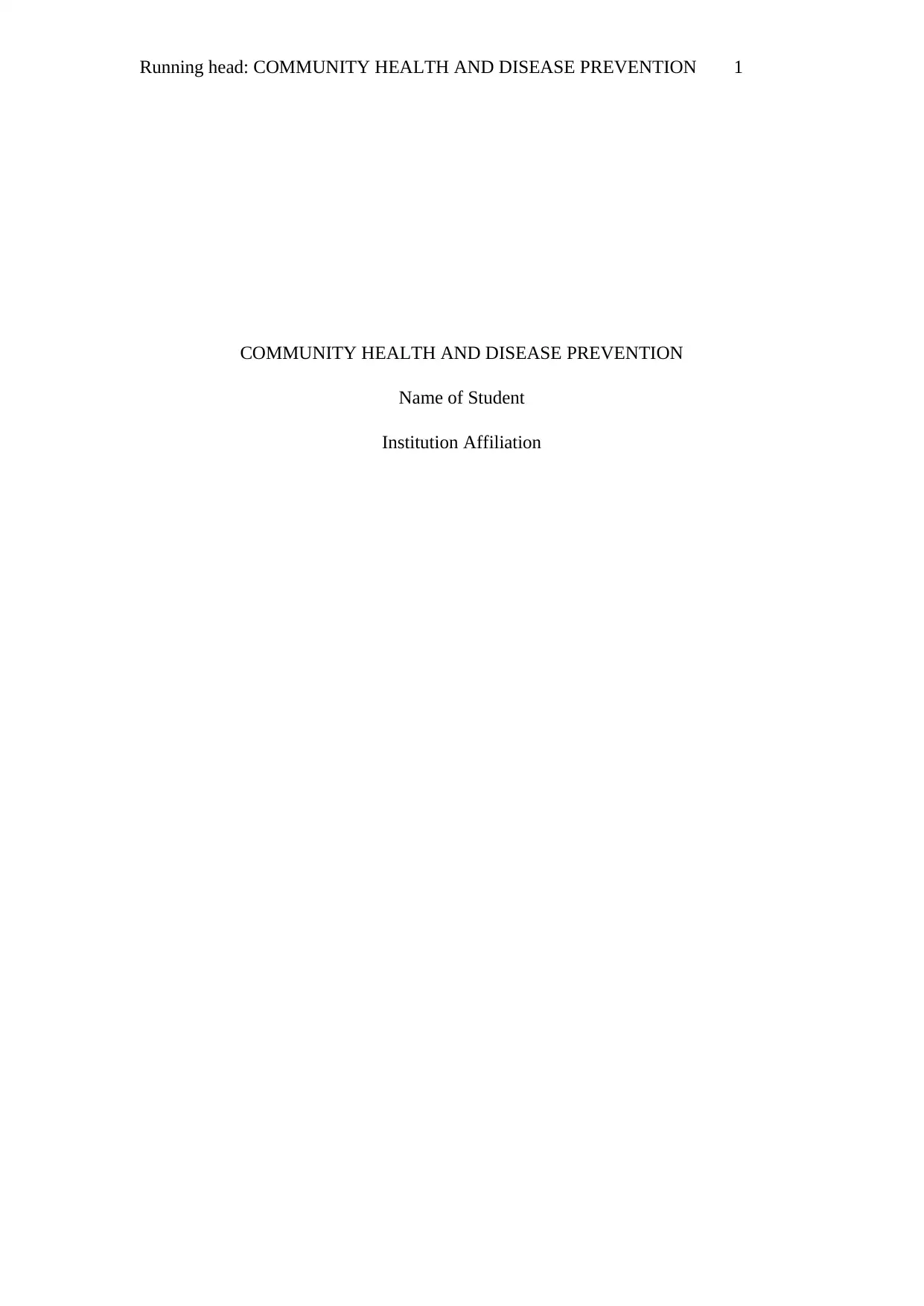
Running head: COMMUNITY HEALTH AND DISEASE PREVENTION 1
COMMUNITY HEALTH AND DISEASE PREVENTION
Name of Student
Institution Affiliation
COMMUNITY HEALTH AND DISEASE PREVENTION
Name of Student
Institution Affiliation
Paraphrase This Document
Need a fresh take? Get an instant paraphrase of this document with our AI Paraphraser
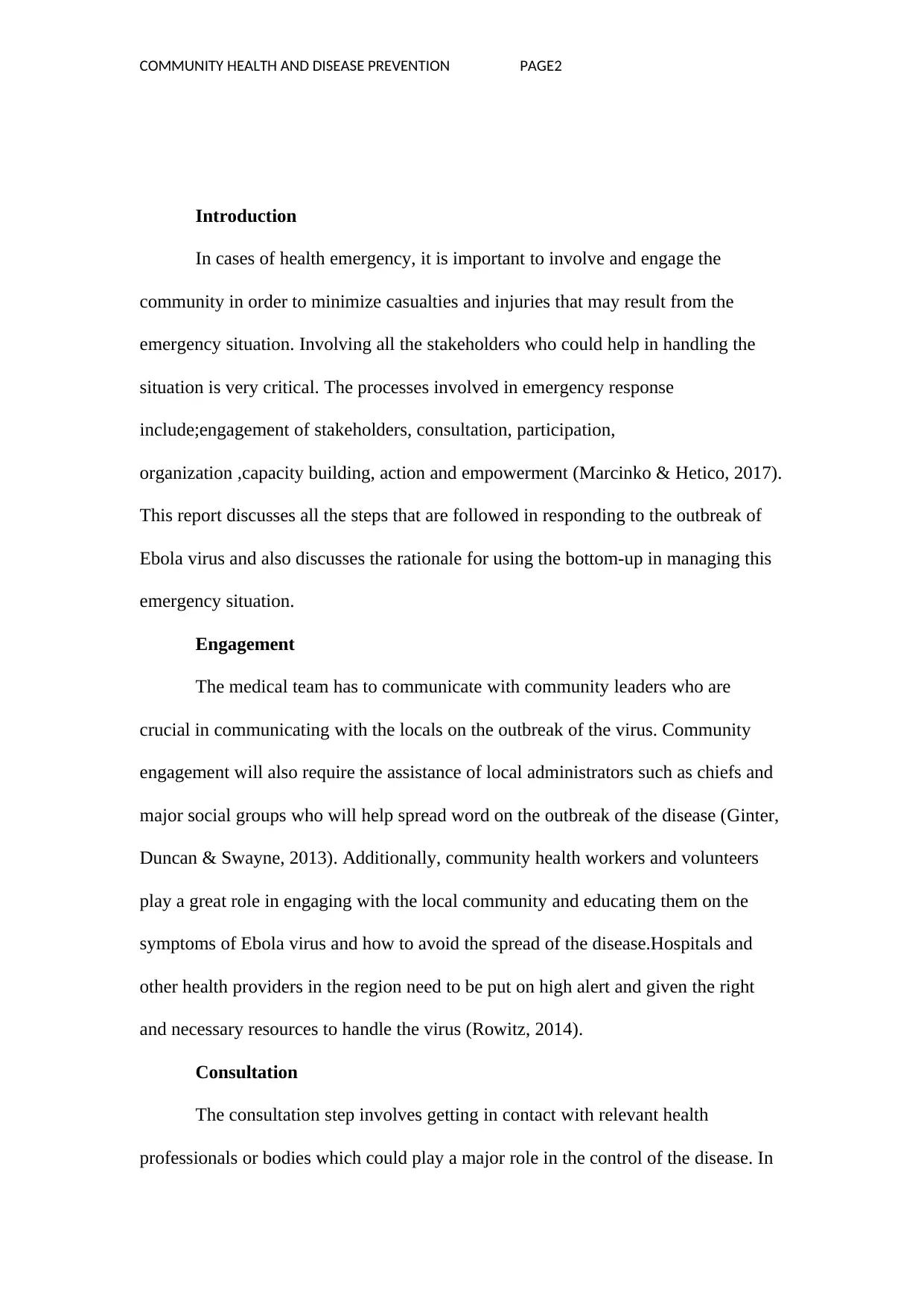
COMMUNITY HEALTH AND DISEASE PREVENTION PAGE2
Introduction
In cases of health emergency, it is important to involve and engage the
community in order to minimize casualties and injuries that may result from the
emergency situation. Involving all the stakeholders who could help in handling the
situation is very critical. The processes involved in emergency response
include;engagement of stakeholders, consultation, participation,
organization ,capacity building, action and empowerment (Marcinko & Hetico, 2017).
This report discusses all the steps that are followed in responding to the outbreak of
Ebola virus and also discusses the rationale for using the bottom-up in managing this
emergency situation.
Engagement
The medical team has to communicate with community leaders who are
crucial in communicating with the locals on the outbreak of the virus. Community
engagement will also require the assistance of local administrators such as chiefs and
major social groups who will help spread word on the outbreak of the disease (Ginter,
Duncan & Swayne, 2013). Additionally, community health workers and volunteers
play a great role in engaging with the local community and educating them on the
symptoms of Ebola virus and how to avoid the spread of the disease.Hospitals and
other health providers in the region need to be put on high alert and given the right
and necessary resources to handle the virus (Rowitz, 2014).
Consultation
The consultation step involves getting in contact with relevant health
professionals or bodies which could play a major role in the control of the disease. In
Introduction
In cases of health emergency, it is important to involve and engage the
community in order to minimize casualties and injuries that may result from the
emergency situation. Involving all the stakeholders who could help in handling the
situation is very critical. The processes involved in emergency response
include;engagement of stakeholders, consultation, participation,
organization ,capacity building, action and empowerment (Marcinko & Hetico, 2017).
This report discusses all the steps that are followed in responding to the outbreak of
Ebola virus and also discusses the rationale for using the bottom-up in managing this
emergency situation.
Engagement
The medical team has to communicate with community leaders who are
crucial in communicating with the locals on the outbreak of the virus. Community
engagement will also require the assistance of local administrators such as chiefs and
major social groups who will help spread word on the outbreak of the disease (Ginter,
Duncan & Swayne, 2013). Additionally, community health workers and volunteers
play a great role in engaging with the local community and educating them on the
symptoms of Ebola virus and how to avoid the spread of the disease.Hospitals and
other health providers in the region need to be put on high alert and given the right
and necessary resources to handle the virus (Rowitz, 2014).
Consultation
The consultation step involves getting in contact with relevant health
professionals or bodies which could play a major role in the control of the disease. In
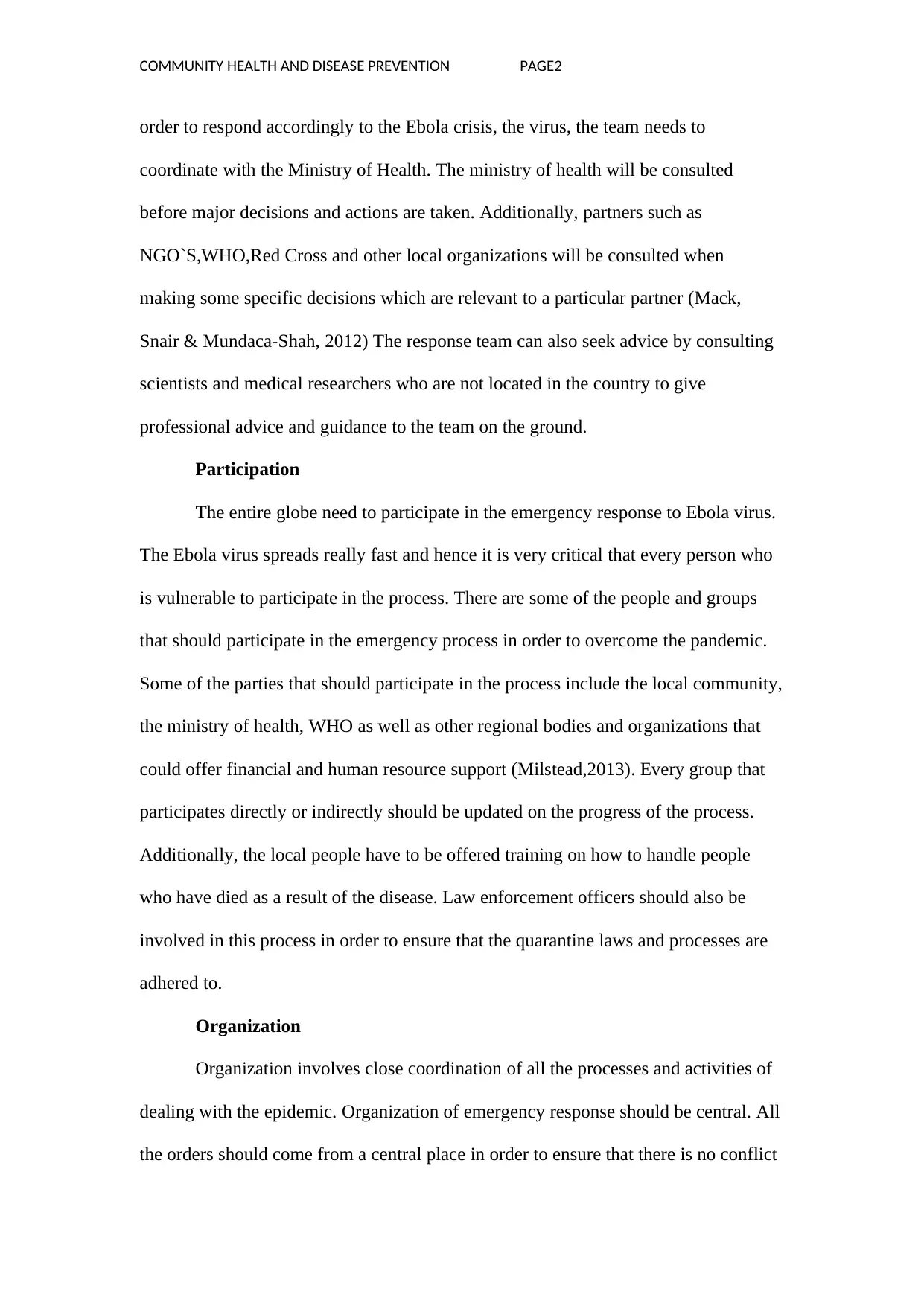
COMMUNITY HEALTH AND DISEASE PREVENTION PAGE2
order to respond accordingly to the Ebola crisis, the virus, the team needs to
coordinate with the Ministry of Health. The ministry of health will be consulted
before major decisions and actions are taken. Additionally, partners such as
NGO`S,WHO,Red Cross and other local organizations will be consulted when
making some specific decisions which are relevant to a particular partner (Mack,
Snair & Mundaca-Shah, 2012) The response team can also seek advice by consulting
scientists and medical researchers who are not located in the country to give
professional advice and guidance to the team on the ground.
Participation
The entire globe need to participate in the emergency response to Ebola virus.
The Ebola virus spreads really fast and hence it is very critical that every person who
is vulnerable to participate in the process. There are some of the people and groups
that should participate in the emergency process in order to overcome the pandemic.
Some of the parties that should participate in the process include the local community,
the ministry of health, WHO as well as other regional bodies and organizations that
could offer financial and human resource support (Milstead,2013). Every group that
participates directly or indirectly should be updated on the progress of the process.
Additionally, the local people have to be offered training on how to handle people
who have died as a result of the disease. Law enforcement officers should also be
involved in this process in order to ensure that the quarantine laws and processes are
adhered to.
Organization
Organization involves close coordination of all the processes and activities of
dealing with the epidemic. Organization of emergency response should be central. All
the orders should come from a central place in order to ensure that there is no conflict
order to respond accordingly to the Ebola crisis, the virus, the team needs to
coordinate with the Ministry of Health. The ministry of health will be consulted
before major decisions and actions are taken. Additionally, partners such as
NGO`S,WHO,Red Cross and other local organizations will be consulted when
making some specific decisions which are relevant to a particular partner (Mack,
Snair & Mundaca-Shah, 2012) The response team can also seek advice by consulting
scientists and medical researchers who are not located in the country to give
professional advice and guidance to the team on the ground.
Participation
The entire globe need to participate in the emergency response to Ebola virus.
The Ebola virus spreads really fast and hence it is very critical that every person who
is vulnerable to participate in the process. There are some of the people and groups
that should participate in the emergency process in order to overcome the pandemic.
Some of the parties that should participate in the process include the local community,
the ministry of health, WHO as well as other regional bodies and organizations that
could offer financial and human resource support (Milstead,2013). Every group that
participates directly or indirectly should be updated on the progress of the process.
Additionally, the local people have to be offered training on how to handle people
who have died as a result of the disease. Law enforcement officers should also be
involved in this process in order to ensure that the quarantine laws and processes are
adhered to.
Organization
Organization involves close coordination of all the processes and activities of
dealing with the epidemic. Organization of emergency response should be central. All
the orders should come from a central place in order to ensure that there is no conflict
⊘ This is a preview!⊘
Do you want full access?
Subscribe today to unlock all pages.

Trusted by 1+ million students worldwide
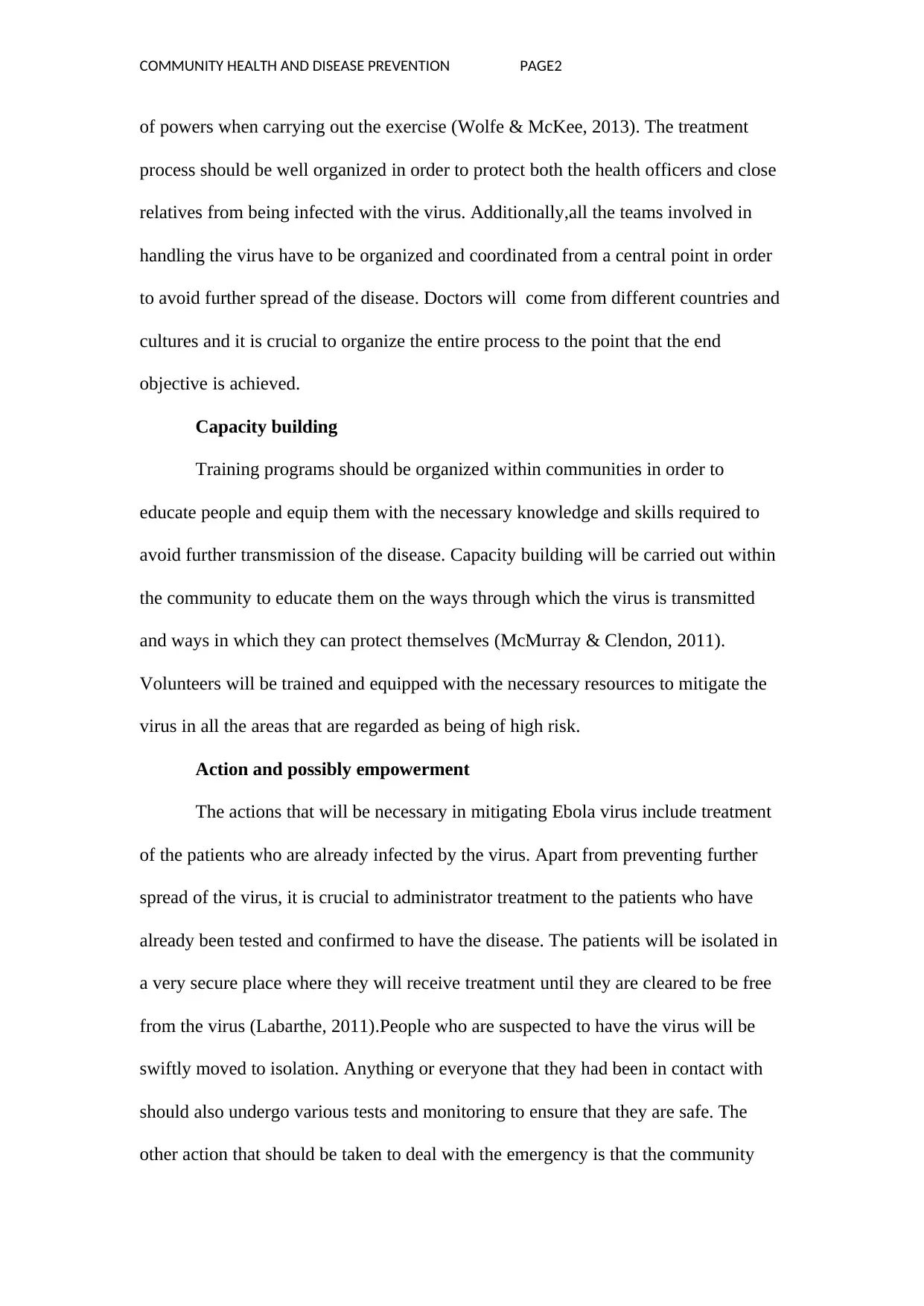
COMMUNITY HEALTH AND DISEASE PREVENTION PAGE2
of powers when carrying out the exercise (Wolfe & McKee, 2013). The treatment
process should be well organized in order to protect both the health officers and close
relatives from being infected with the virus. Additionally,all the teams involved in
handling the virus have to be organized and coordinated from a central point in order
to avoid further spread of the disease. Doctors will come from different countries and
cultures and it is crucial to organize the entire process to the point that the end
objective is achieved.
Capacity building
Training programs should be organized within communities in order to
educate people and equip them with the necessary knowledge and skills required to
avoid further transmission of the disease. Capacity building will be carried out within
the community to educate them on the ways through which the virus is transmitted
and ways in which they can protect themselves (McMurray & Clendon, 2011).
Volunteers will be trained and equipped with the necessary resources to mitigate the
virus in all the areas that are regarded as being of high risk.
Action and possibly empowerment
The actions that will be necessary in mitigating Ebola virus include treatment
of the patients who are already infected by the virus. Apart from preventing further
spread of the virus, it is crucial to administrator treatment to the patients who have
already been tested and confirmed to have the disease. The patients will be isolated in
a very secure place where they will receive treatment until they are cleared to be free
from the virus (Labarthe, 2011).People who are suspected to have the virus will be
swiftly moved to isolation. Anything or everyone that they had been in contact with
should also undergo various tests and monitoring to ensure that they are safe. The
other action that should be taken to deal with the emergency is that the community
of powers when carrying out the exercise (Wolfe & McKee, 2013). The treatment
process should be well organized in order to protect both the health officers and close
relatives from being infected with the virus. Additionally,all the teams involved in
handling the virus have to be organized and coordinated from a central point in order
to avoid further spread of the disease. Doctors will come from different countries and
cultures and it is crucial to organize the entire process to the point that the end
objective is achieved.
Capacity building
Training programs should be organized within communities in order to
educate people and equip them with the necessary knowledge and skills required to
avoid further transmission of the disease. Capacity building will be carried out within
the community to educate them on the ways through which the virus is transmitted
and ways in which they can protect themselves (McMurray & Clendon, 2011).
Volunteers will be trained and equipped with the necessary resources to mitigate the
virus in all the areas that are regarded as being of high risk.
Action and possibly empowerment
The actions that will be necessary in mitigating Ebola virus include treatment
of the patients who are already infected by the virus. Apart from preventing further
spread of the virus, it is crucial to administrator treatment to the patients who have
already been tested and confirmed to have the disease. The patients will be isolated in
a very secure place where they will receive treatment until they are cleared to be free
from the virus (Labarthe, 2011).People who are suspected to have the virus will be
swiftly moved to isolation. Anything or everyone that they had been in contact with
should also undergo various tests and monitoring to ensure that they are safe. The
other action that should be taken to deal with the emergency is that the community
Paraphrase This Document
Need a fresh take? Get an instant paraphrase of this document with our AI Paraphraser
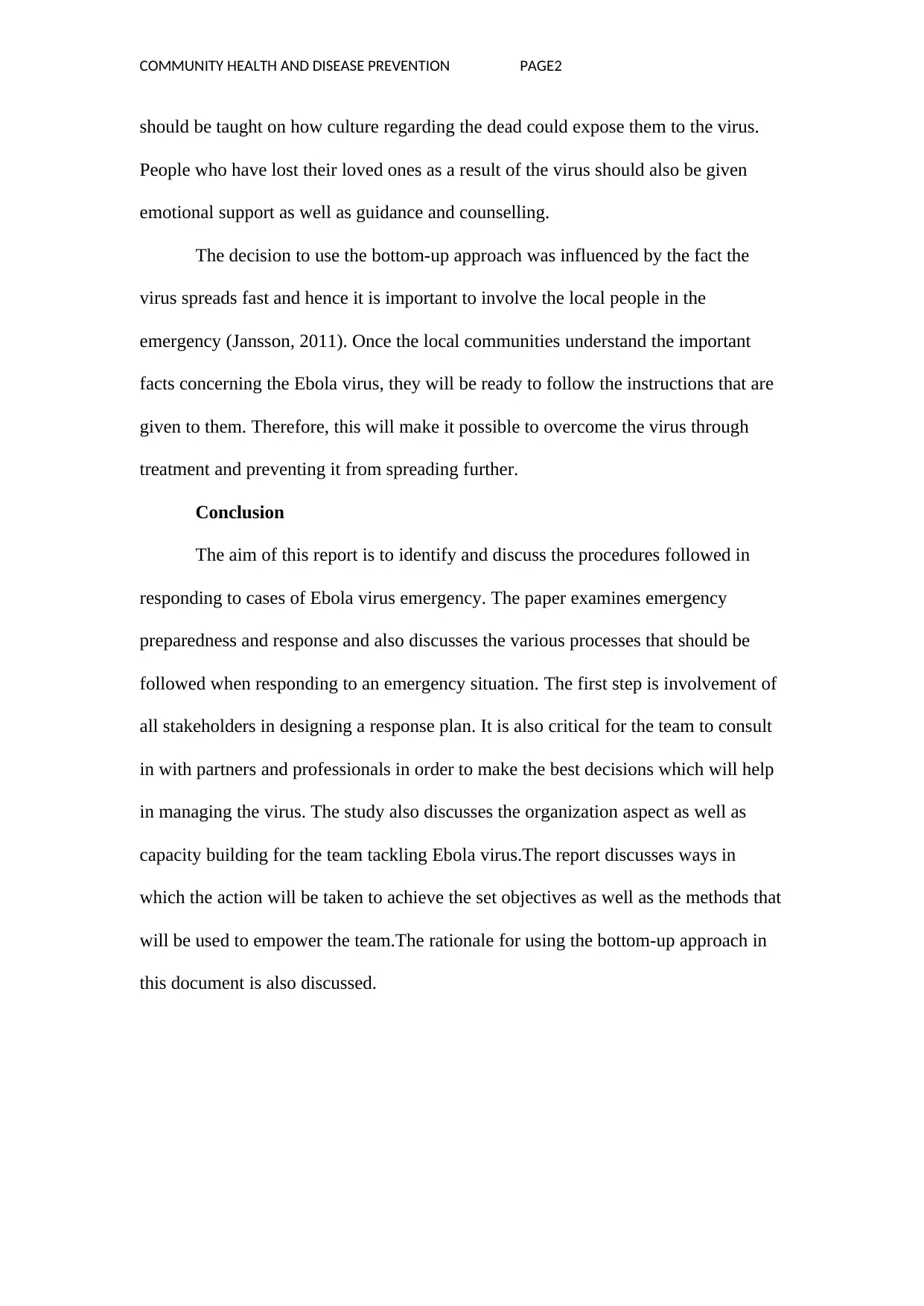
COMMUNITY HEALTH AND DISEASE PREVENTION PAGE2
should be taught on how culture regarding the dead could expose them to the virus.
People who have lost their loved ones as a result of the virus should also be given
emotional support as well as guidance and counselling.
The decision to use the bottom-up approach was influenced by the fact the
virus spreads fast and hence it is important to involve the local people in the
emergency (Jansson, 2011). Once the local communities understand the important
facts concerning the Ebola virus, they will be ready to follow the instructions that are
given to them. Therefore, this will make it possible to overcome the virus through
treatment and preventing it from spreading further.
Conclusion
The aim of this report is to identify and discuss the procedures followed in
responding to cases of Ebola virus emergency. The paper examines emergency
preparedness and response and also discusses the various processes that should be
followed when responding to an emergency situation. The first step is involvement of
all stakeholders in designing a response plan. It is also critical for the team to consult
in with partners and professionals in order to make the best decisions which will help
in managing the virus. The study also discusses the organization aspect as well as
capacity building for the team tackling Ebola virus.The report discusses ways in
which the action will be taken to achieve the set objectives as well as the methods that
will be used to empower the team.The rationale for using the bottom-up approach in
this document is also discussed.
should be taught on how culture regarding the dead could expose them to the virus.
People who have lost their loved ones as a result of the virus should also be given
emotional support as well as guidance and counselling.
The decision to use the bottom-up approach was influenced by the fact the
virus spreads fast and hence it is important to involve the local people in the
emergency (Jansson, 2011). Once the local communities understand the important
facts concerning the Ebola virus, they will be ready to follow the instructions that are
given to them. Therefore, this will make it possible to overcome the virus through
treatment and preventing it from spreading further.
Conclusion
The aim of this report is to identify and discuss the procedures followed in
responding to cases of Ebola virus emergency. The paper examines emergency
preparedness and response and also discusses the various processes that should be
followed when responding to an emergency situation. The first step is involvement of
all stakeholders in designing a response plan. It is also critical for the team to consult
in with partners and professionals in order to make the best decisions which will help
in managing the virus. The study also discusses the organization aspect as well as
capacity building for the team tackling Ebola virus.The report discusses ways in
which the action will be taken to achieve the set objectives as well as the methods that
will be used to empower the team.The rationale for using the bottom-up approach in
this document is also discussed.

COMMUNITY HEALTH AND DISEASE PREVENTION PAGE2
References
Ginter, P. M., Duncan, W. J., & Swayne, L. E. (2013). Strategic management of
health care organizations. San Francisco, CA: Jossey-Bass, Wiley.
Jansson, B. S. (2011). Becoming an effective policy advocate: From policy practice to
social justice. Belmont, CA: Brooks/Cole.
Labarthe, D. (2011). Epidemiology and prevention of cardiovascular diseases: A
global challenge. Sudbury, Mass: Jones and Bartlett Publishers.
Mack, A., Snair, M., & Mundaca-Shah, (2012). The ebola epidemic in West Africa
(1st ed.).
Marcinko, D. E., & Hetico, H. R. (2017). Dictionary of health information technology
and security. New York: Springer Pub.
Milstead, J. A. (2013). Health policy and politics: A nurse's guide. Burlington, MA:
Jones & Bartlett Learning.
McMurray, A., & Clendon, J. (2011). Community health and wellness: Primary
health care in practice. Chatswood, N.S.W: Elsevier Australia.
Rowitz, L. (2014). Public health leadership: Putting principles into practice.
References
Ginter, P. M., Duncan, W. J., & Swayne, L. E. (2013). Strategic management of
health care organizations. San Francisco, CA: Jossey-Bass, Wiley.
Jansson, B. S. (2011). Becoming an effective policy advocate: From policy practice to
social justice. Belmont, CA: Brooks/Cole.
Labarthe, D. (2011). Epidemiology and prevention of cardiovascular diseases: A
global challenge. Sudbury, Mass: Jones and Bartlett Publishers.
Mack, A., Snair, M., & Mundaca-Shah, (2012). The ebola epidemic in West Africa
(1st ed.).
Marcinko, D. E., & Hetico, H. R. (2017). Dictionary of health information technology
and security. New York: Springer Pub.
Milstead, J. A. (2013). Health policy and politics: A nurse's guide. Burlington, MA:
Jones & Bartlett Learning.
McMurray, A., & Clendon, J. (2011). Community health and wellness: Primary
health care in practice. Chatswood, N.S.W: Elsevier Australia.
Rowitz, L. (2014). Public health leadership: Putting principles into practice.
⊘ This is a preview!⊘
Do you want full access?
Subscribe today to unlock all pages.

Trusted by 1+ million students worldwide

COMMUNITY HEALTH AND DISEASE PREVENTION PAGE2
Wolfe, I., & McKee, M. (2013). European child health services and systems: Lessons
without borders.
Wolfe, I., & McKee, M. (2013). European child health services and systems: Lessons
without borders.
1 out of 7
Related Documents
Your All-in-One AI-Powered Toolkit for Academic Success.
+13062052269
info@desklib.com
Available 24*7 on WhatsApp / Email
![[object Object]](/_next/static/media/star-bottom.7253800d.svg)
Unlock your academic potential
Copyright © 2020–2025 A2Z Services. All Rights Reserved. Developed and managed by ZUCOL.




